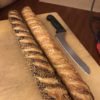Brendan Francis Newnam: How did you get into dying clothes with food?
Cara Marie Piazza: I went to college in London where I was studying textiles. We had a workshop with this lovely lady – I completely forgot her name, which is terrible – she ran a workshop with us on natural dying. One of the things she was doing was using food, spices. She showed us how to dye with tumeric.
I was sitting here going “Ah, if we can use tumeric, maybe we can use other things.” And I remembered reading about I think it’s a Romanian Easter egg dye made from onion skins. So I pretty much just hit the kitchen and started playing with it.
Brendan Francis Newnam: How is it possible that onions can become dye? What color dye?
Cara Marie Piazza: You can get anything from a really beautiful rusty deep orange to a light yellow, and with different assists like allum or different metals like iron, you can get a dark green.
Brendan Francis Newnam: Tell me about the shift to food waste.

Cara Marie Piazza: I am a really big advocate of sustainability in fashion, so it kind of bothered me that as I was doing this I was wasting the food.
Brendan Francis Newnam: So how does that work, practically? Do you just see a compost bin and you’re like, there it is?
Cara Marie Piazza: [Laughs] Well, no. I have actually partnered with certain restaurants. I worked with Reynard at the Whythe Hotel and they were awesome. We tried a project for a month where the chefs there actually siphoned off a bunch of the food there that they would throw away into buckets, and I did two pick-ups a week which was insane. Now I have onion skins to last me a lifetime.
Brendan Francis Newnam: Give me like the five kind of basic pieces of food waste that you use for dying.
Cara Marie Piazza: Onion skins is a big one. Avacado peels. Any kind of tops, like, if you buy organic carrots or fennel, anything that has a large rooty thing coming out of the top of it. You have to chop it off anyway before you cook it. That makes like a really beautiful green. Coffee grinds, tea. Squid ink I love. I don’t eat squid that often and, you know, the ink sacks are quite small, so that’s more of a gourmet dye, I guess you would say.
Brendan Francis Newnam: So this is an existential question that lies at the heart of your project: What is the difference between what you do and a stain? I spill stuff on my clothes all the time and I don’t get written up in Vogue.
Cara Marie Piazza: Oh, gosh! Well, you know what, I guess I just make it look good.
Brendan Francis Newnam: So it’s controlled staining.
Cara Marie Piazza: Controlled staining. Ordered chaos.
Brendan Francis Newnam: There are some other questions. When you stain your shirt, besides the fact that maybe it just looks whack, it also disappears, it doesn’t stay consistent. So how do you shift from a stain to an actual dye?
Cara Marie Piazza: To fix a natural dye onto any natural fabric, you need something called a mordant. What a mordant is is a chemical assist – in my case it’s a natural chemical, non-toxic – that will bind the color of the fabric. So you use allum or washing soda, different teas provide different tannins…
Brendan Francis Newnam: Can you show me how this dye works? You have these two big pots. One is a humongous pot filled with onion skins. And this looks like fennel fronds?

Cara Marie Piazza: Yes. This is extracting the dye. You put the stuff in a pot with water. You cover it so all of the matter is pretty evenly covered over. You let it cook for about half an hour, two hours, however long, until the color turns the color you want. Then what you do – the fun part – is you strain it into your bigger pot.
Brendan Francis Newnam: You are basically pouring the material through a sieve.
Cara Marie Piazza: Pouring them, with cereals, through a sieve, and then adding it to more water. I’m going to be dying a large amount of fabric. Watch out, it’s a little bit hot!
Right now I am just dying a set of aprons. What I’ve done here is something called shibori. It is a Japanese binding technique. You basically fold the fabric like it is origami and you bind it with bulldog clips.
Brendan Francis Newnam: Bulldog clips, for people who can’t see it, they’re just like those big, black clips you use for files. It’s like tie-dye. You can use rubber bands, you can use clips…
Cara Marie Piazza: Shibori is a really fancy word for tie-dye. It makes it sound way more high-class.
Brendan Francis Newnam: So, how long will that hang out in there?
Cara Marie Piazza: This guy is probably going to hang out for about half an hour and then I’m going to check up on it, add more color, mess around until it’s the way I like it.
Brendan Francis Newnam: And then the next phase would be you would remove it and just kind of hang it out to dry?
Cara Marie Piazza: You remove it. You hang it out to dry. Once it dries naturally, you iron it. The heat sets the color. That is another way of setting the color.
Brendan Francis Newnam: And then you have to wash it so it doesn’t smell like onions!
Cara Marie Piazza: And then you have to wash it so it doesn’t smell like onion. And then you iron it again, unless you like it wrinkled.
Brendan Francis Newnam: Do you like plain clothes? Like, I’m wearing a white shirt, right now. Does it upset you?

Cara Marie Piazza: No, it doesn’t upset me at all. I actually have taken to wearing a uniform of all white. I think because I deal with color, all day, every day, I just like having a stark uniform. By uniform I mean white jeans and a white tee shirt.
Brendan Francis Newnam: What you’re wearing is not white right now. You look like a tablecloth after somebody had a blueberry pie eating contest.
Cara Marie Piazza: I’m going to take that as a compliment?


